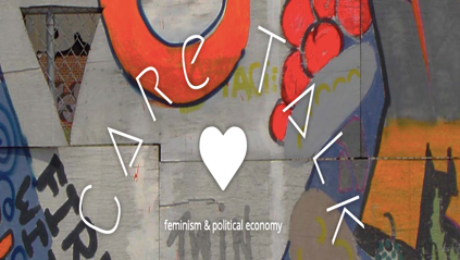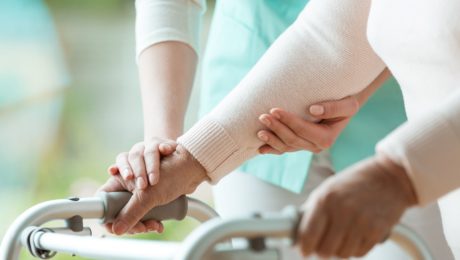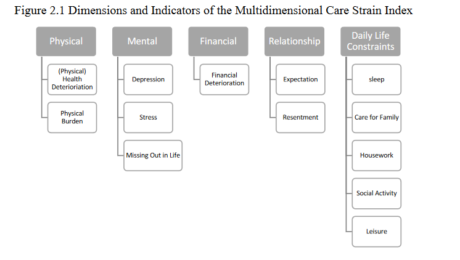Are We All Care Workers Now?
Who, exactly, are care workers, other than the people we need most right now, as the covid-19 pandemic overlays the division of labor with a new division of risk?
I’ve long been an advocate of using the term “care worker” rather than “caregiver” even though the work can be and often is, at least in part, a gift. Because care–whether performed for pay, or not–is at the crux of any sustainable economic system. All work depends on the successful production and maintenance of workers themselves. Yet because this very notion of care-as-work is relatively new, there is little agreement on its exact boundaries.
When I first started pursuing this issue with Paula England, we emphasized hands-on or face-to-face work that develops the capabilities of the care recipient, an essential aspect of the services that health care providers, workers, child care and elder care workers provide. This emphasis could be translated into a specific list of Census-designated occupations, grounding empirical research on the relative pay of care workers that has revealed significant pay penalties for both women and men in such occupations, controlling for many other variables such as education, experience, and unionization.
I liked this broad definition because it spanned paid and unpaid work, low-wage and relatively high-wage occupations, women and men, creating potential for new political alliances. Sociologists initially embraced the definition with some enthusiasm. Not so, economists, and Robert Solow, who attended some meetings of the Russell Sage Foundation Network on Care Work, pushed us for more specificity.
I felt some affinity with Kenneth Arrow’s insistence on the limits of markets and with efficiency-wage theories pointing to the difficulty of monitoring worker productivity, so added another twist to the definition: work in which concern for the welfare of the care recipient is likely to affect the quality of the service provided. In other words, work not performed entirely for money, akin to what some economists have termed “public service motivation” but more…personal.
Still not quite right. Sociologist Mignon Duffy has argued eloquently in Making Care Count that this definition privileges what she calls “nurturant care,” deflecting attention from the drudgery of menial care tasks–the emptying of bed pans, cleaning of toilets, and mopping of floors often performed by the most disempowered members of society. “Dirty” work itself is devalued. Duffy’s work has nudged me to focus more on industry–the economic consequences, for instance, of being employed in health care, education, or social services, regardless of occupation.
The pandemic, however, has pushed me over a cliff, because it is redefining the meaning of “dirty” work–now, any work that increases the risk of exposure to a potentially deadly virus: not just health care, child care, and elder care and unpaid care for family members, but also food services, package delivery, police protection, home repair services, garbage collection…the list goes on. We rely heavily on the motivations of such workers to minimize our own–as well as their own–chances of infection.
The entire sequestration/shelter-in-place/social distancing strategy relies heavily on good will and voluntary compliance. The very invisibility of covid-19 blurs the boundaries between love and money, us and them. The healthy now may later be sick, the sick now may later be dead. When risk is shared, the overlaps between solidarity and self-interest expand.
Yet so many boundaries, however blurry, remain in place. Whether because of who they are or what they do, some workers face much greater risks than others. It’s not enough to cheer them on, to offer them applause or a bit of extra cash.
If we are all care workers now we should do everything in our power to protect our own.
Original blog published on CARE TALK: FEMINIST AND POLITICAL ECONOMY on April 4, 2020. See https://blogs.umass.edu/folbre/
Reposted with permission from Dr. Nancy Folbre from University of Massechusetts Amherst and an expert researcher for the Care Work and the Economy Project
- Published in Child Care, COVID 19, elderly care
A Time for Reflection on Care
The world outside my study is churning and whirling… as it is engulfed with the fast-evolving health situations in communities around the globe. There are many unknowns about the
COVID-19 illness that has spread rapidly in every continent and the presence of uncertainty—big time—has rattled governments, shaken markets, and upended our daily routines, to say the least.
While I join the hundreds of millions of people who constantly check the news online and in newspapers, radio and/or tv, I also take time to pause. These moments allow me to reflect on
what this difficult time that we are all experiencing means and what it says about us—as
individuals, as members of communities, and as citizens of the world.
For one, I find that:
- each individual action has multitudes of rippling effects, large and small, on others;
- the real world oscillates between predictability and unpredictability; it requires each of us to constantly assess the balance between taking caution and taking risk;
- the distinction between self-interest and altruism (promoting others’ interests) becomes more blurred given the pervasive interconnectedness of our lives;
- adaptation and flexibility are vital life skills that we need to have not just now but at all times;
- we have the ability to change as we obtain more information and as conditions around us change; the notion of fixed tastes and preferences is outmoded;
- the skills that we must hone and develop should prepare us not only to live in a competitive world but also to be able to work together, coordinate and cooperate with one another; for the greater good requires collective action.
As the impacts of the COVID-19 spread intensify, there is growing recognition among governments and the public that traditional efforts for dealing with shocks and managing risks through conventional emergency responses are inadequate. Strategic thinking is needed as much as the ability to respond quickly and to take proactive measures. There is an urgent need to build the adaptive capacity and longer-term resilience of communities and societies.
One striking fact about the current global pandemic is its tremendous effect on the care sector. This includes not only the health care systems employing doctors, nurses, aides, and other health professionals but also the unpaid care labor provided by family members, neighbors, and kin.
Many are changing their daily life patterns to provide further assistance and care support for those who are vulnerable such as their parents or grandparents and for those who are self-quarantined. Many more are willing to take the risk of exposure to care for those who have tested positive and are ill but are staying at home because the healthcare system is inadequate, inaccessible, and/or overwhelmed. The shutdown of schools and daycare centers further adds demand for unpaid care. Parents are struggling to care for their children while at the same time trying to tele-work from home.
“How can I write or have meetings with my six-year old around?”
The cloak or mantle that hides the emerging crisis of social reproduction, or the under- provision of care for people who depend on it, is removed. This global pandemic exposes the heavy demand on those who carry the responsibility for providing care for the sick, the young and the frail elderly, the vast majority of whom have been women. It has upended preconceived notions such as: each individual is a ‘Robinson Crusoe’ in families that can find their own solutions to provide care, and that one’s ability to pay should determine who accesses care in the private sector.
The Care Work and the Economy Project joins the efforts of other organizations, research institutions and advocacy groups towards making the care sector visible to policymakers. The heavy care burden that is now being shouldered by health care systems, households, communities and countries throughout the world makes it imperative to bring care work out of statistical shadows and to remove the veil of ignorance in economic policymaking.
Let us hope that this time is truly different and that the jolt brought about by the current pandemic leads to more openness in the academic community and among policymakers towards a paradigm shift and policy change.
March 2020
- Published in Child Care, COVID 19, elderly care, Maria Floro, Policy
Measuring the Overall Strain of Caregiving: A Multidimensional Approach
Providing care for others, especially for the frail elderly and young children, is one of the most important forms of human work that sustains our existence. However, caregiving is also often challenging and strenuous. Many informal caregivers are known to suffer negative physical, emotional, and social outcomes, and are at risk of losing their own health and well-being. Fengler and Goodrich, for example, refer to the wives of frail elderly men as ‘the hidden patient,’ warning the negative consequences of caregiving on informal caregivers. Since the 1980s, several instruments have been developed to measure the strain of caregiving among informal caregivers. Some measurements such as the Zarit Burden Interview and the Caregiver Strain Index have been applied more widely, while other measurements have been used for more specific groups of caregivers (e.g., who takes care of the elderly with cancer). Although these measures provide valuable information on various dimensions of caregiver strain, they are not sufficient to assess the overall level of strain experienced by caregivers. In most cases, these measurements consist of a list of questions or statements about the caregiver’s burden; the sum of the answers is then used to indicate the level of burden/strain experienced by the caregiver. Although useful, a simple non-weighted sum of answers may not be an accurate representation of the overall strain. For instance, two groups of caregivers may have the same average total strain score, but one group may consist of all caregivers who suffer strain in some statements, while the other group may have half of the care givers who suffer strain in all statements and the other half who do not suffer strain at all. While the marginal distribution may be the same, the joint distribution may not, and this has an important policy implication.
Adapting the Alkire-Foster method developed to measure multidimensional poverty, Jun et al (2019) propose a threshold-based approach to measuring overall caregiving strain that accounts for the multidimensionality of the caregiving experience. The approach is based on the premise that as in the case of poverty, the negative consequences of multiple strains attached to caregiving would be greater than the sum of their individual effects. The authors first identify the dimensions and indicators that are known to be important consequences of caregiving, such as physical, psychological, financial and relational strains, and daily life constraints. They then count the overlapping strains a care giver experiences under different indicators of caregiver strain. Next, they identify caregivers who are experiencing strains above a specific cut-off point as multi-dimensionally strained. This measure is tested using the data from the newly collected Survey of Eldercare and Childcare in Korea 2018, exploring whether receiving support, help and appreciation may be associated with reduced chance of being multi-dimensionally strained. By providing an overall measurement that identifies caregivers with multiple strains, the authors examine 1) which group of caregivers are more likely to be at risk; 2) which dimensions do most caregivers suffer strain; and 3) what may be potential buffers for caregiving strain.
This paper will be available December 2019
This blog was authored by Jiweon Jun, Ki-Soo Eun and Ito Peng
- Published in South Korea, Understanding and Measuring Care
- 1
- 2



